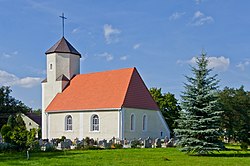Rębiszów
Rębiszów | |
|---|---|
Village | |
 Church of the Visitation of the Virgin Mary | |
 Rębiszów | |
| Coordinates: 50°57′03″N 15°26′57″E / 50.95083°N 15.44917°ECoordinates: 50°57′03″N 15°26′57″E / 50.95083°N 15.44917°E | |
| Country | |
| Voivodeship | Lower Silesian |
| County | Lwówek Śląski |
| Gmina | Mirsk |
| Population (2017[1]) | 703 |
| Time zone | UTC+1 (CET) |
| • Summer (DST) | UTC+2 (CEST) |
| Area code(s) | +48 75 |
| Vehicle registration | DLW |
Rębiszów [rɛmˈbiʂuf] (German: Rabishau) is a village in the administrative district of Gmina Mirsk, within Lwówek Śląski County, Lower Silesian Voivodeship, in south-western Poland, close to the Czech border.[2]
The village has a population of 700.
There are two historic churches in Rębiszów: the Church of the Visitation, which dates back to the 16th century and the Saint Barbara church from the 18th century. There is also a train station in the village.
History[]

The name of the village comes from the Polish word rąbać ("chop"), referring to chopping trees.[3] Its oldest form was Rąbyn.[3] In the Liber fundationis episcopatus Vratislaviensis from around 1300 the village was mentioned under the Latinized name Rabysow.
Before 1945 the village was German-settled and part of the German state of Prussia. During World War II, the Germans created a forced labour camp for English, Yugoslav and French prisoners of war in the village.[4] In the final stages of World War II, in January-February 1945, in the Rębiszów forest, the Germans carried out executions of forced laborers and prisoners of war, who were caught trying to escape from German labor camps.[5]
References[]
- ^ "Wieś Rębiszów (dolnośląskie)". Polska w liczbach (in Polish). Retrieved 19 October 2019.
- ^ "Central Statistical Office (GUS) – TERYT (National Register of Territorial Land Apportionment Journal)" (in Polish). 2008-06-01.
- ^ Jump up to: a b Heinrich Adamy, Die Schlesischen Ortsnamen ihre Entstechung und Bedeutung. Breslau: Verlag von Priebotsch’s Buchhandlung, 1888, p. 41
- ^ Edward Basałygo, 900 lat Jeleniej Góry. Tędy przeszła historia. Kalendarium wydarzeń w Kotlinie Jeleniogórskiej i jej okolicach, Jelenia Góra, 2010, p. 255 (in Polish)
- ^ Basałygo, Op. cit., p. 265-266
- Villages in Lwówek Śląski County
- Lwówek Śląski County geography stubs

